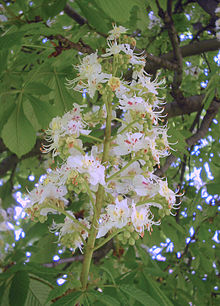Berangan kuda
| Berangan kuda | |
|---|---|
 | |
| Aesculus hippocastanum, the European horse chestnut | |
| Klasifikasi ilmiah | |
| Spesies tipe | |
| Aesculus hippocastanum L. | |
| Species | |
|
Genus Aesculus atau berangan kuda terdiri dari 13–19 spesies tumbuhan berbunga dalam famili Sapindaceae. Mereka adalah pohon dan semak yang berasal dari belahan bumi utara yang beriklim sedang, dengan enam spesies asli Amerika Utara dan tujuh hingga 13 spesies asli Eurasia.[1][2][3] [4] [5] [6] [7] [8] [9] [10][11][12][13][14][15][16][17][18][19][20][21]
Referensi
- ^ Ogg, J.G.; Gradstein, F.M.; Gradstein, F.M. (2004). A geologic time scale 2004. Cambridge, UK: Cambridge University Press. ISBN 978-0-521-78142-8.
- ^ Scottish Garden Buildings by Tim Buxbaum p.11
- ^ "'Thujoy Khreshchatyk'. Why Kyivans miss chestnuts and how they became a symbol of the capital", Ukrayinska Pravda (29 May 2019) (dalam bahasa tidak diketahui)
- ^ Carnival Campaign: How the Rollicking 1840 Campaign of "Tippecanoe and Tyler Too" Changed Presidential Elections Forever, by Ronald Shafer, 2016
- ^ Sunset Western Garden Book, 1995:606–607
- ^ Hardin, JW. 1957. A revision of the American Hippocastanaceae I. Brittonia 9:145-171
- ^ Hardin, JW. 1957. A revision of the American Hippocastanaceae II. Brittonia 9:173-195
- ^ Hardin, JW. 1960. A revision of the American Hippocastanaceae V, Species of the Old World. Brittonia 12:26-38
- ^ Harlan, Jack R. (1995). The Living Fields: Our Agricultural Heritage (edisi ke-1. publ.). Cambridge [u.a.]: Cambridge Univ. Press. hlm. 15. ISBN 978-0-521-40112-8.
- ^ Akazawa, T.; Aikens, C.M. (1986). Prehistoric Hunter-Gathers in Japan. University of Tokyo Press.
- ^ Aikens, C.M.; Higachi, T. (1982). Prehistory of Japan. New York Academic Press.
- ^ Hall, Alan (1976). The Wild Food Trail Guide (edisi ke-second). New York: Holt, Rhinehart and Winston. hlm. 214.
- ^ Peterson, Lee (1977). A field guide to edible wild plants of eastern and central North America. Boston: Houghton Mifflin Co. hlm. 172.
- ^ Nelson, Guy (2006). Ohio Buckeye (Aesculus glabra Willd.), Plant Guide. Washington, D.C.: US Department of Agriculture, Natural Resources Conservation Service.
- ^ Dale, Thomas R.; Scogin, Dixie B. (1988). 100 woody plants of Louisiana. Monroe, Louisiana: The Herbarium of Northeast Louisiana University. hlm. 118.
- ^ https://www.primitiveways.com/fish_poison.html Fishing with Poisons]
- ^ Judd, W.S.; Sanders, R.W.; Donoghue, M.J. (1994). "Angiosperm family pairs". Harvard Papers in Botany. 1: 1–51.
- ^ Hardin, JW. 1957. A revision of the American Hippocastanaceae I. Brittonia 9:145-171.
- ^ Guide to Poisonous Plants
- ^ Harrington, Mark G.; Edwards, Karen J.; Johnson, Sheila A.; Chase, Mark W.; Gadek, Paul A. (Apr–Jun 2005). "Phylogenetic inference in Sapindaceae sensu lato using plastid matK and rbcL DNA sequences". Systematic Botany. 30 (2): 366–382. doi:10.1600/0363644054223549. JSTOR 25064067. Parameter
|s2cid=yang tidak diketahui akan diabaikan (bantuan) - ^ New York Flora Atlas: Aesculus hippocastanum










